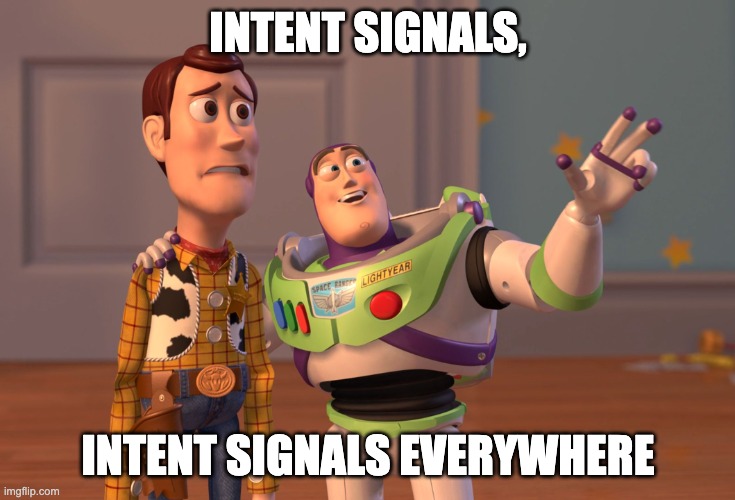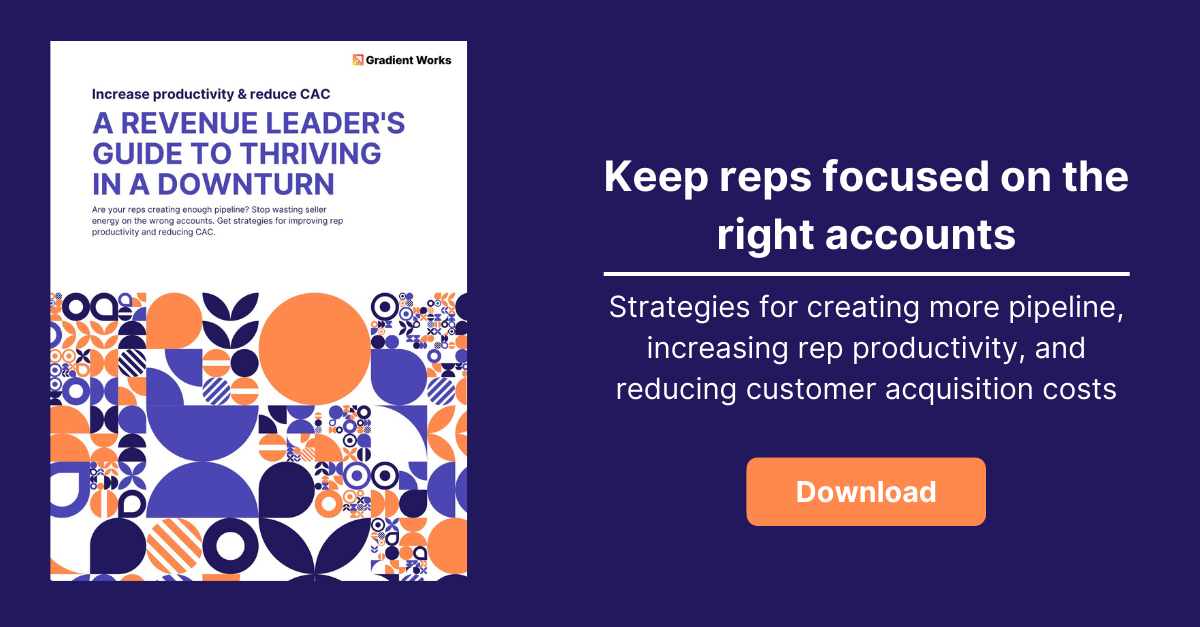There are so many classic, ongoing battles in history: The Hatfields and McCoys, dog people vs cat people, sales vs marketing. Arguably, 90% of the sales and marketing friction comes from lead quality and how to measure it.
As more companies adopt an ABM or ABX motion, customer buying signals, actions (intent signals) and how to react to them have become the focal point of sales and marketing teams to identify ready prospects to win new business. That being said, you don’t have to be an account-based organization to capitalize on intent signals. Many companies incorporate some sort of intent marketing but rarely do not push forward into sales strategy. In this blog, we will cover intent signal types and how to leverage them.
What are intent signals vs intent data
It’s important to define intent signals compared to intent data. Many use the term interchangeably, but they are quite different. Intent signals come from customer buying signals/behavior that indicates they are showing interest and/or interacting with your company/product/brand. Look at it as a verb. Intent data, on the other hand, is contextual information like Demographic, Firmographic, and Technographic information. Intent data helps identify your ICP, like adjectives. (Sorry for the elementary school English class metaphor) We will cover those in a different blog. Today, we want ACTION!
In B2B, marketers love hand raisers. They are the low-hanging fruit of intent signals. Those signals are usually: a form fill for content, webinars, demo requests, etc. However, there is an entire world of online anonymous signals you can use. These signals don’t require the prospect to fill out anything and leave them open to a long sales cadence they didn’t ask for. Using tools like a reverse IP lookup can identify researchers that are visiting your most important pages. How much better would sales and marketing outreach be if they knew a prospect:
- Visited the pricing page 3 days in a row
- Watched a product demo video
- Read the reviews from customers
The internal struggle doesn’t come from identifying intent signals, but instead, how to act on them. Let’s look at how you can leverage intent signals.
How to use intent signals
 Too many go-to-market teams grab intent signals and stare blankly at them until they decide who to call. Instead, use them to prioritize who to call first.
Too many go-to-market teams grab intent signals and stare blankly at them until they decide who to call. Instead, use them to prioritize who to call first.
There is a sweet spot between intent data and your ideal customer. This combination of fit and timing (more on that topic here) focuses your teams on the highest value targets.
Use intent signals for lead scoring
A lot of lead scoring systems I have seen focus on 2 things: the ICP and the hand-raiser signals. This is because they are the easiest to track. However, creating an intent data lead scoring system based on anonymous intent signals can ensure your team reaches out first to the most high-value, high-converting leads. Here at Gradient Works, we use a variety of these signals concerning anonymous traffic, including:
- Number of web page visits
- Visited a product page
- Social media engagement
An important note: these signal intent but do not necessarily always result in sales outreach. As the prospect adds points and downloads assets, we segment those prospects across the funnel for marketing outreach. First-time visitors and lower-scored prospects (TOFU) are retargeted in specific campaigns. Median numbers and certain asset views (MOFU) get enrolled in a nurture campaign. High scores get routed to sales (with notifications) and enrolled in sales outreach (BOFU).
Use intent signals for planning
One thing both marketing and sales can fundamentally agree on is data. Marketers love intent signals because they can use them to plan upcoming campaigns. For example, a spike in traffic around Salesforce moving away from Process Builder and into Flow gave Gradient Works the opportunity to write more about our Flow expertise and create a hub of expert content.
Sales teams love intent signals for similar reasons. Salesforce research found that 84% of customers say being treated like a person is “very important” to winning their business. Knowing the prospect’s traffic, content interests, etc. makes it easier to make a personalized connection as opposed to a cold outreach. When the teams work together, you can create custom content about those topics/pain points to further move the prospect through the buying cycle.
Why intent signals matter
Identifying and prioritizing prospects and customers likely to buy focuses energy on the most important leads. Spend less time on low-value prospects or manually sorting lists to target, wasting valuable time. It has a few other benefits as well.
1. Increasing your return on advertising spend
Wallets are squeezed and discretionary spending is lower than ever. Using intent signals replaces one-to-many marketing tactics hoping for an obvious form fill or demo request. Instead, you can concentrate marketing spend based on their intent within the funnel. This shortens sales cycle time and keeps your prospect interested.
2. Lowers your customer acquisition cost
Targeting prospects with the right information during their customer journey overwhelmingly lowers the cost of chasing leads that don’t fit your ICP and aren’t showing valuable signals. For example, a good retargeting campaign on video and/or content moves a prospect farther down the funnel than your awareness campaign push.
3. Product-led growth when reduced inbounds
Intent signals aren’t only the domain of prospects. Your current customers give you an immediate view of intent. For use-based products, are they reaching their limit every month? Is a recent hiring spree adding more users? These product-based signals indicate a time for cross-sell and up-sell that can help meet revenue goals, especially in a slower inbound lead cycle.
Customer signals can also reduce churn. Is your customer viewing the cancellation page? Are they doing product research for competitors? Proactively reaching out to resolve issues, find product gaps, and creates a better customer experience and customer satisfaction.
Automate the process
So many intent signals go unnoticed and opportunities fall through the cracks because of manual processes. Someone checks the signals once a week, informs sales of who might be ready, sales hunts them down in the CRM, and calls this week (maybe) if there isn’t another initiative that takes precedence. There are too many points of failure.
Instead, automate these tasks. Dynamically build books of business with Gradient Works. Even more importantly, when a lead score is changing due to intent signals, automatically inform the rep in Slack, Teams, Email, or all of the above. Gradient Works can also auto-enroll these leads into a SalesLoft or Outreach cadence, ensuring no lead is left behind.





